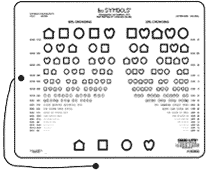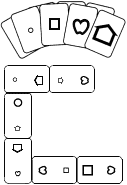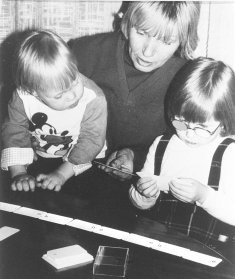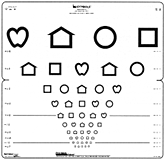Visual Acuity Tests
A great majority of the LEA Tests are visual acuity tests to allow measurement of visual acuity in all clinical situations. One of the most common areas is vision screening in preschool and school age.
The basic visual acuity test is the line test where the distance between the symbols, the optotypes, is equal to the width of the symbols, as recommended by the International Council of Ophthalmology in 1984 and 1988 and WHO 2003.
Near Vision Tests
 |
In infants and children visual functions at near distances are more important than visual functions at greater distances. Therefore visual acuity should always be first measured at a near distance. Visual acuity at near is measured with the line tests, which is the basic measurement. |
 |
In children who are about to learn to read, the reverse side of the near vision test with more crowded symbols gives an idea about the size of the text that the child can handle. |
 |
Visual acuity measured with single symbols, either using single LEA Playing Cards or the LEA Domino Cards reveals what is the smallest symbol that the child can discern when there is no disturbing visual information around. This is very important information to be compared with visual acuity values measured with line and crowded tests when testing amblyopic eyes and vision in children who have brain damage. |
Thus for near vision acuities we have three different acuity values:
- the basic line test acuity,
- visual acuity measured with more crowded symbols and
- visual acuity measured with single symbols.
|
The Playing Cards and the Domino Cards are useful in training of amblyopic eyes and at the same time introduce the test situation to younger siblings in the family or younger children in a day care centre/nursery school. |
 |
 |
Training of the test situation can be started very early, before the age of one year by using the three dimensional symbols of the LEA 3-D Puzzle. Since the concept similar - different is first learned in relation to colours, one side of the puzzle is based on colours and the other side on black and white forms. When the test symbols are introduced in a play situation with the puzzle, measurement of visual acuity is possible as early as at the age of 14 months. |
Distance vision tests
Visual acuity for distance vision is measured with tests held at three meter distance. If that distance is too great for a young child, testing can be performed at two meter distance. In older children measurement can made at greater distances up to six meters if the child has vision tasks at that distance.


For testing children 5 years of age and older, the basic test of visual acuity at distance is the 15-line Folding Chart or the back illuminated charts on either the small lightbox or the big EDTRS-lightbox. In these charts there are two or three sets of symbols in the lower rows so that measurement of binocular and monocular values can be made by using different sets of symbols. This prevents memorising. The charts with several sets of symbols in the lower rows are too difficult for 3-4-year-old children. For them there is the chart with 10 lines and only one set of symbols.
 |
If even the 10-line Chart is too difficult, the Crowded Symbol Book with five symbols in a group functions as a miniature line test where the central symbol functions as the test symbol. In the assessment of severely visually impaired children this distance test, like all distance tests, can be used as a near vision test. |
 |
If the child can concentrate on looking at only one symbol at the time, the Single Symbol Test Book or Flash Cards can be used. However, it is important to remember that visual acuity measured with single symbols is not comparable to visual acuity measured with the line test. It is usually 2-4 lines better than visual acuity measured with a line test. |

If we use seven visual acuity tests of the LEA Vision Test System, it is possible to get seven different visual acuity values when assessing vision of a child with brain damage related changes in oculomotor functions and visual processing.
| Distance | – single | 1.63 |  |
| – line test | 0.80 | ||
| Near 40cm | – single (first) | 0.40 | |
| – sreening | 0.25 | ||
| – standard test | 0.20 | ||
| – 50% spacing | 0.16 | ||
| – 25% spacing | 0.12 |
Back illuminated distance vision charts

In the U.S., the National Eye Institute requires that visual acuity measurements for research purposes are made on visual acuity tests that are back illuminated at a standard luminance level. The light boxes are of two different sizes, the large so called EDTRS light box where a full size visual acuity test can be used and a small light box on which the largest symbols are three lines smaller.

The small light box is easily caried and can be used with both paediatric and adult visual acuity charts at high and low contrast levels. Its use is demonstrated Follow-up of Vision Development of healthy children to detect amblyopia (lazy eye) and eye turn or strabismus.
The LEA SYMBOLS® have been chosen for several screening instruments, such as the INSTA-LINE by Good-Lite, the Massachusetts Visual Acuity Test and the VIP-test. These modifications try to make testing easier for the tester. A typical screening test in several States of the United States contains only those lines of the visual acuity chart that are used in screening symptom free children.
Screening programs and tests for assessment using LEA SYMBOLS® are also a part of computer based tests by:
 M&S Technologies, INC
M&S Technologies, INC
P.O.Box 1171
Park Ridge, IL 60068, U.S.A.
FAX +1-773-467 0816
jmarino@mstec.com
For more information, see the Instructions Section: LEA SYMBOLS® Visual Acuity Tests.
Paediatric Vision Tests I Vision Tests I Instructions Section I Main Page
Edited on 1.7.2009.